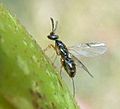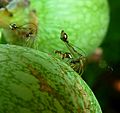Fig wasp facts for kids
Quick facts for kids Fig wasps |
|
|---|---|
 |
|
| Blastophaga psenes female | |
| Scientific classification | |
| Kingdom: | |
| Phylum: | |
| Class: | |
| Order: | |
| Suborder: | |
| Superfamily: | |
Fig wasps are tiny wasps that spend their early lives inside figs. These amazing insects have a very special connection with fig plants. Most fig wasps help the fig trees make seeds by carrying pollen. This process is called pollination. However, some fig wasps just live inside the figs and eat them without helping the plant.
Fig wasps are not all from the same family. They are a "polyphyletic" group. This means they look similar and live in figs, but they come from different family lines of wasps. The fig wasps that pollinate figs belong to a special family called Agaonidae. These wasps often create small bumps, called galls, inside the fig. Other types of fig wasps might make their own galls or use galls made by other fig wasps.
Contents
What Are Fig Wasps?
Fig wasps are small insects, often just a few millimeters long. They are part of a larger group of wasps called Chalcidoidea. These wasps are famous for their unique life cycle. It is completely tied to the life of a fig fruit.
Tiny Helpers and Their Homes
Fig wasps are very important for fig trees. Without them, many fig trees would not be able to make new seeds. Each type of fig tree usually has its own special type of fig wasp. This means they have evolved together over millions of years.
The Amazing Fig-Wasp Partnership
The relationship between fig wasps and fig trees is one of nature's most incredible partnerships. It is a type of mutualism. This means both the wasp and the fig tree benefit from each other.
How Pollination Works
The female fig wasp enters a young fig fruit through a tiny opening called the ostiole. Inside the fig, she lays her eggs. As she moves around, she also spreads pollen from another fig tree. This pollen helps the fig tree make seeds.
Life Inside the Fig
After the female wasp lays her eggs, she usually dies inside the fig. Her eggs hatch into larvae. These larvae grow by eating parts of the fig. They develop into adult wasps inside the fig.
New Wasps Emerge
Male wasps usually hatch first. They are often wingless and spend their short lives inside the fig. Their main job is to fertilize the female wasps. The fertilized female wasps then collect pollen. They chew their way out of the fig, carrying pollen with them. They then fly off to find a new fig tree to lay their eggs in, starting the cycle again.
Different Types of Fig Wasps
Not all fig wasps are pollinators. Some are called "non-pollinating" fig wasps.
Pollinating Fig Wasps
These wasps are the true partners of the fig tree. They belong to the Agaonidae family. They are essential for the fig tree's reproduction. Without them, the fig tree cannot produce fertile seeds.
Non-Pollinating Fig Wasps
These wasps also live inside figs. However, they do not help with pollination. Instead, they might lay their eggs in the fig and feed on its tissues. Some are parasitoid wasps. This means they lay their eggs inside other fig wasp larvae. When their eggs hatch, the new larvae eat the host larvae.
Why Are Fig Wasps Important?
Fig wasps are vital for the health of many ecosystems. Fig trees are a "keystone species" in many tropical forests. This means they are very important for many other animals. Birds, monkeys, and other creatures rely on figs for food. Without fig wasps, these fig trees would not produce fruit. This would impact many other animals that depend on them.
Images for kids
-
Pleistodontes sp. female
-
Ceratosolen species are pollinators of the Sycomorus, Sycocarpus and Neomorphe sections of Ficus.
-
Non-pollinating parasitoid wasps Apocrypta ovipositing on Ficus sur in South Africa
See also
 In Spanish: Avispa de los higos para niños
In Spanish: Avispa de los higos para niños





